CitroŽn at the 2007 Internationale
Automobil-Ausstellung in Frankfurt
|
 |
CITROňN C4 HYBRIDE HDi
A solution to significantly reduce fuel
consumption and CO2 emissions
|

|
CitroŽn
is presenting the C4 Hybride HDi demonstration
vehicle, combining a
hybrid powertrain with a HDi engine. This vehicle
allies the
exceptional efficiency of the HDi diesel engine
(consuming 20% less
fuel than a petrol engine) used over its most
effective operating
range, with the advantages of an electric motor,
suited mainly to city
driving.
The C4 Hybride HDi boasts low fuel consumption (3.4
l/km) and low CO2
emissions (90 g/km). At the same time, it maintains
the renowned
driving pleasure of HDi engines, backed up by the
specific advantages
of the hybrid powertrain, such as all-electric mode at
low speeds.
This
demonstration vehicle is based on cutting-edge
technology already
available in the CitroŽn range, including: the HDi
engine, particulate
filter (DPFS), Stop & Start and the six-speed
electronic gearbox
system. These technologies work together to reduce
fuel consumption and
pollutant emissions.
At the same time, the styling of the
C4 is based on a clear architectural choice: limited
height for
optimised aerodynamics and fuel consumption.
The C4 also
has a wealth of other advantages, in terms of styling,
technology
content and road manners. CitroŽn has sold over
640,000 C4s worldwide
since launch in November 2004, in a market segment
accounting for a
third of all vehicle sales.
The C4 Hybride HDi is a medium-term solution that
will enable CitroŽn to bring real progress in fuel
consumption and CO2
emissions and to make these benefits available to the
greatest number
in a European market where diesel vehicles have strong
presence.
|
C4 Hybride HDi
Hybrid HDi technology on a successful model
Hybrid HDi technology, a pertinent choice
The C4 Hybride HDi combines a hybrid drive train and
a HDi diesel engine to bring decisive progress in fuel
consumption and CO2 emissions.
Petrol/hybrid technology does not significantly
outperform HDi diesel technology in terms of fuel
consumption and CO2 emissions.
The
work carried out by PSA Peugeot CitroŽn has shown that
a petrol hybrid
car consumes as much as fuel as a car equipped with a
conventional
diesel engine with identical characteristics (such as
weight,
dimensions and Cd.A). At the same time, the petrol
version cuts CO2 emissions by just 10%. Yet
petrol hybrids cost a great deal more than their
diesel equivalents.
High-tech
(HDi) diesel engines have enjoyed growing success on
the European
market since the end of the 1990s. Today, diesel
engines are fitted on
one in two passenger vehicles on average, compared
with one in four in
1998. In some countries, such as France, diesel
vehicles accounted for
70% of sales in 2006. This continuous growth in sales
shows that
consumers are keen to buy low-consumption vehicles
that make no
trade-offs in driving pleasure and that are compatible
with their
purchasing power.
Also, with the additional benefits of
the particulate filter (DPFS), diesel engines are
extremely impressive
environmental performers. CitroŽn has sold more than
500,000 vehicles
equipped with the DPFS to date.
|
|
This
being so, it is understandable that so few petrol
hybrid vehicles have
been sold in Europe, despite the tax advantages
offered by some
European Union member states.
Advantages of the HDi engine
The
C4 is an all-round performer, at ease in the city, on
the road and on
the motorway. Combining a hybrid system with a HDi
engine, it allies
the outstanding fuel economy of the HDi diesel engine
(consuming 25%
less fuel than a petrol engine), used over its best
operating range,
with the advantages of an electric motor, suited
mainly to city
driving.
In the city and on the open road, the hybrid system
brings real gains in consumption (3.4 l/100 km over a
combined cycle) and CO2
emissions (90 g/km). A diesel hybrid vehicle
outperforms an equivalent
vehicle fitted with a petrol hybrid system by 25%, or
one litre every
100 km over a combined cycle, for a significant
increase in range.
The
intrinsic qualities of the HDi engine, mated to the
high-performance
six-speed electronic gearbox system, improve fuel
consumption by 25% on
the motorway.
Furthermore, no sacrifices have been made
in terms of driving pleasure, which remains a priority
for motorists.
The C4 Hybride HDi fulfils this requirement, while
offering motorists
additional driving pleasure in two areas:
- first,
in the city and at low speed, the combustion engine
goes into stand-by,
functioning entirely in electric mode (ZEV: Zero
Emission Vehicle), for
increased acoustic comfort and vibration control.
- second, the C4 Hybride HDi responds to driver
input
to provide far better acceleration than a combustion
engine of
equivalent power. The driver can thus gain as much
as 23 kW of extra
power generated by the electric motor, compared with
the combustion
engine alone.
C4, an aerodynamic model of appropriate qualities
The C4 Hybride HDi is a medium-term solution that
will enable CitroŽn to bring real progress in fuel
consumption and CO2 emissions and to make
these benefits available to the greatest number.
The
C4 is the CitroŽn vehicle best suited to developing
hybrid HDi
technology. It is a family car, designed for a wide
variety of uses
(city, open road and motorway), which fulfils the key
requirements of
the European market. CitroŽn sold over 190,000 C4s in
Western Europe in
2006 in the most popular market segment, accounting
for more than 30%
of total vehicle sales.
The C4 is designed for
outstanding aerodynamic performance, one of CitroŽnís
traditional
strengths. It has an excellent drag coefficient, a
mere 0.28 for the
coupť version Ė the model chosen for the C4 Hybride
HDi demonstration
vehicle. This achievement contributes directly to
reducing fuel
consumption and CO2 emissions.
Lastly, the C4 has all the qualities needed to
satisfy a wide range of customer expectations.
The
C4 is available as both a hatchback and a coupť. Each
model has its own
strong and distinctive styling, but they share the
same generous space.
The hatchback has rounded forms, whereas the coupť
favours a sharper
line.
The C4 passenger compartment is designed to be both
comfortable and relaxing. It combines understated
high-tech interior
styling Ė witnessed in the pure lines of the dashboard
Ė with
innovations that are both user-friendly and
ergonomic.
The
multifunctional fixed-centred controls steering wheel
brings the main
comfort functions and driving aids within easy reach.
It is associated
with an innovative instrument cluster that displays
information on a
translucent strip in the centre of the
dashboard.
In
addition to its impeccable road manners, the C4 offers
a wealth of
modern and efficient driving aids. These include Xenon
dual-function
directional headlamps, tyre pressure detector, and the
lane departure
warning system (LDWS), which, on a motorway or a fast
road, warns the
driver if the car crosses a continuous or dotted lane
marking, if the
indicator is not activated.
|
Concerning
occupant protection, the C4 received five stars in
EuroNCAP impact
tests. The C4 is fitted with six airbags, and also
boasts the world's
first shape-optimised driver airbag, a feature made
possible by the
fixed central section of the steering wheel, which
protects the
driver's chest more effectively. The C4 obtained
excellent results in
pedestrian impact, with three stars out of a possible
four, and in
child protection, with four stars out of a possible
five.
Cutting-edge technology from the CitroŽn range on
the C4 Hybride HDi
The
C4 Hybride HDi relies extensively on the cutting-edge
technology
already used in the CitroŽn range, including: the HDi
engine,
particulate filter (DPFS), Stop & Start and the
electronic gearbox
system.
The Hybrid HDi also features an electric motor, a
power inverter, a high-tension battery pack and a
regenerative braking system.
These technologies work together to reduce fuel
consumption and pollutant emissions.
|
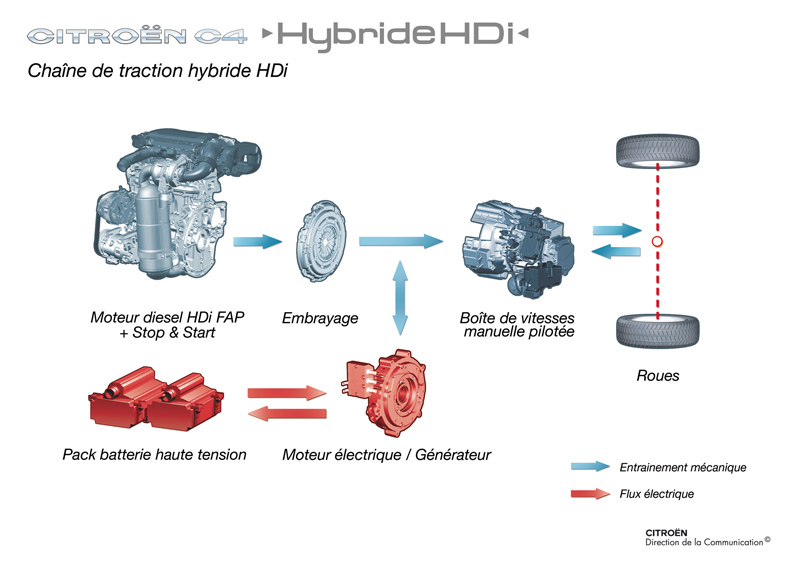 |
|
HDi engine and DPFS
The
C4 Hybride HDi is equipped with a 1.6 HDi engine
developing 66 kW EEC
(92 bhp DIN) at 4,000 rpm. It supplies torque of
215 Nm at 1,750 rpm.
CitroŽn modified the engine to make it compatible
with a hybrid drivetrain.
In
particular, it has a dedicated control system, using
operating
instructions coordinated directly by the powertrain
management unit.
These instructions control engine stops and starts,
while delivering
the torque required by the driver.
To ensure outstanding
emission performance, the engine has been fitted with
a new-generation
particulate filter (DPFS) that exceeds the Euro IV
standard.
The
trade-off between NOx emissions and fuel consumption
has been improved,
using the degree of freedom provided by the hybrid
system. CitroŽn was
thus able to use the capabilities of the electric
motor to manage
engine shutdown time and to use the combustion engine
at its most
efficient operating points.
|
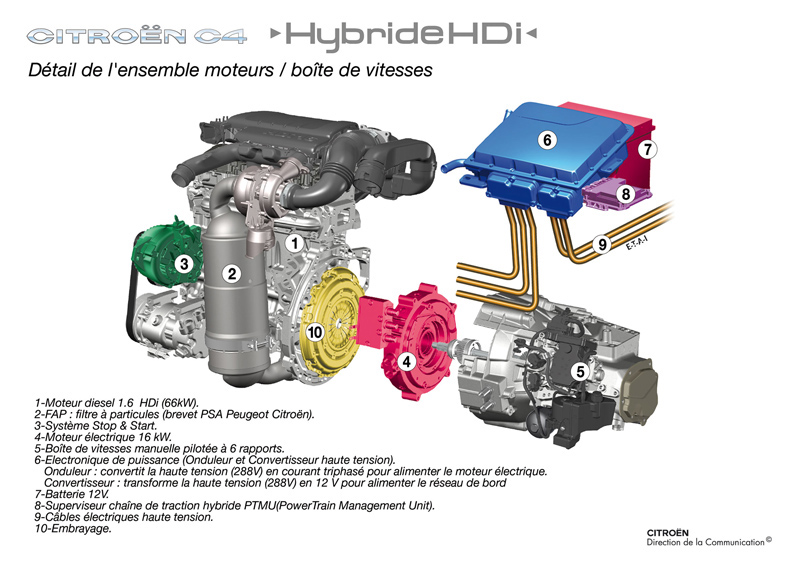 |
Electronic gearbox system
The
C4 Hybride HDi benefits from gains in fuel savings
provided by the
six-speed electronic gearbox system. This gearbox is
already available
on the C4, C4 Picasso and Grand C4 Picasso.
The
electronic gearbox system fitted is an automated
version of a manual
shift without a clutch pedal. The gearboxís hydraulic
control system
shifts gears more quickly, thus enhancing driving
pleasure. At the same
time, it continuously manages the powertrain by
selecting the best
operating point in real time. The gearbox thus
delivers ensures the
best trade-off between consumption, acceleration,
braking, driving
pleasure and emission control. And it leaves the
driver free to choose
automatic or sequential mode for gear changes.
Stop & Start system
Following
the C2 and C3, the C4 Hybride HDi is equipped with the
Stop & Start
system which, in the hybrid powertrain, serves to
restart the
combustion engine.
On C2 and C3, Stop & Start
technology cuts the engine just before the vehicle
comes to a
standstill (traffic lights, traffic jams, etc.), and
remains in standby
while the driver keeps a foot on the brake pedal. It
starts again
automatically and instantaneously as soon as the
driver takes his or
her foot off the pedal to move forward again. These
micro-hybrid
vehicles cut fuel consumption and CO2
emissions by around 10% over an urban cycle and 6%
over a combined cycle.
On
the C4 Hybride HDi, the Stop & Start system boasts
40% more power
than the first generation system, to restart the HDi
92 engine.
In
addition, while the Stop & Start function on the
C2 and C3 only
kicks in when the vehicle stops and restarts, it can
be activated at
any time on the C4 Hybride HDi if the vehicle is
travelling at less
than 60 kph.
When the driver accelerates hard, the Stop &
Start system immediately activates the combustion
engine.
|
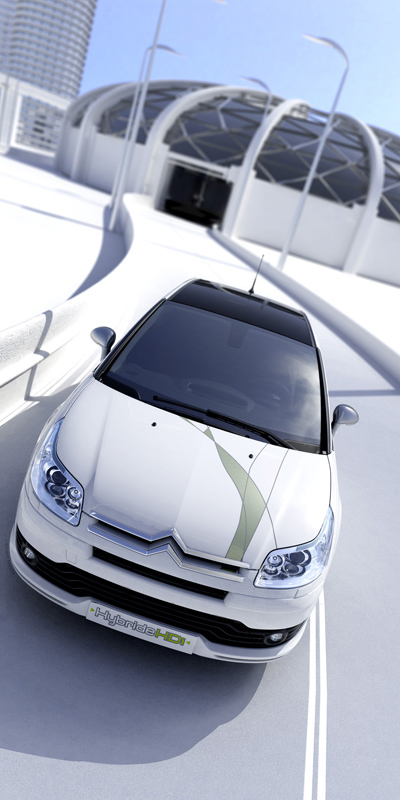 |
|
Electric motor and power inverter
The
electric motor develops 16 kW of continuous power for
80 Nm of torque.
It provides peak power of 23 kW for 130 Nm of torque
to meet occasional
demand from the driver. CitroŽn has made a design
trade-off between
size and performance to make the technology compatible
for use in the
city. Power levels were set to ensure that the
vehicle can run in
electric mode for speeds of up to 50 kph, typical of
city driving
conditions. The hybrid powertrain control system
selects this mode
whenever conditions Ė in particular the battery charge
level Ė permit.
The
electric motor uses synchronous permanent magnet
technology, offering
the best size-performance ratio currently available.
Connected to the
power inverter, it operates in a voltage range of
between 210 and 380
volts. Given the limited space available, the electric
motor and power
inverter cannot be used with a conventional engine
cooling system since
its temperature is typically too high. Water cooling
process is thus
provided by a special radiator and a low-temperature
circuit at 60įC.
The
power inverter regulates the torque of the electric
motor by
controlling the current from the battery pack Ė in the
same way as an
injection pump adjusts the fuel supply from the tank
when the driver
accelerates.
|
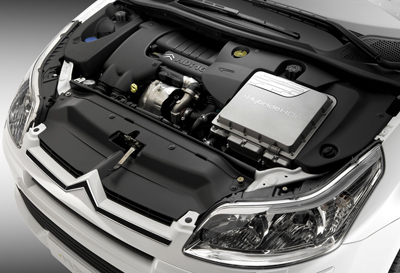 |
|
High-voltage battery pack
The
high-voltage battery pack is fitted in the boot, where
the spare tyre
would usually be. This involved making a slight
modification to the
cut-out of the compartment. The batteries
do not reduce boot capacity.
The
high-voltage battery pack consists of 240 Ni-MH
(Nickel Metal Hydride)
cells, delivering 23 kW of power at a nominal
voltage of 288 volts.
The battery cells are cooled by special air intakes
that recover air
from the cabin, taking advantage of its temperature
control.
The vehicle maintains the conventional 12V battery,
which continues to handle its usual functions.
|
 |
|
Controlled regenerative braking
When
the car decelerates or brakes, the controlled braking
system optimises
the transformation from kinetic energy to electric
energy. This
electric energy is stocked in the high-voltage battery
pack.
It can then be used in electric mode or to boost the
combustion engine during acceleration.
This process provides a "free" source of energy, thus
further reducing fuel consumption.
|
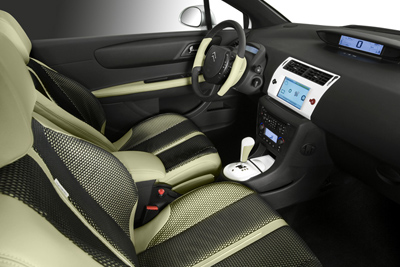 |
Operating principle of the C4
Hybride HDi
Intuitive and easy to use
Turning
the key in the ignition starts the car but not the
combustion engine.
When the driver accelerates, the electric motor alone
can drive the
vehicle forward, depending on the pressure placed on
the pedal. The
combustion engine kicks in when the driver accelerates
more
emphatically.
The electronic gearbox system delivers the
same level of efficiency as a manual gearbox, while
supplying the
automation necessary for the hybrid powertrain. The
decision to shift
gears and the actual change takes place automatically
without input
from the driver, unless he or she opts for sequential
mode.
All of these functions are managed transparently by
the Power Train Management Unit (PTMU).
The
PTMU selects the best operating mode for low fuel
consumption,
depending on the driver's actions. This is normally
achieved by using
the electric motor on its own at low speeds and during
deceleration,
the combustion engine on its own on main roads and
motorways, or both
when greater acceleration power is required.
Intelligent braking control
One of the advantages of the hybrid system is its
ability to recover kinetic energy from the vehicle for
later use.
When
the driver takes his or her foot off the accelerator
pedal at a speed
of under 60 kph, the combustion engine goes into
stand-by and is
disconnected. The electric engine then provides engine
braking and
recovers the kinetic energy from the vehicle.
The PTMU stores this
energy in the batteries until they are fully charged.
When
the driver brakes, the PTMU controls brakeforce
distribution, using
electric braking (regenerative) and hydraulic braking
(dissipative),
while giving priority to safety functions. It also
optimises energy
recovery to reduce fuel consumption.
The NaviDrive control screen
C4
Hybride HDi drivers receive real time data on
powertrain operation via
the large colour 16/9 screen of the NaviDrive
telematics system. The
screen provides clear and immediately understandable
on energy
transfers between the combustion engine, the electric
motor, the
battery pack and the wheels.
Additional information is
also available, such as the battery charge levels or
the power
requested by the driver from the combustion engine or
electric motor.
This system makes the driver more aware of how the
vehicle works, thus encouraging a more economical
driving style.
Special functions
- All-electric mode: a ZEV (Zero Emission
Vehicle) driving
The
ZEV button on the central console lets the driver
select an "extended"
all-electric mode, optimising the normal operating
range of the vehicle
in electric mode.
This allows motorists to drive further
and faster than they normally would in hybrid mode,
without activating
the combustion engine. In this case, the combustion
engine is used only
for harder acceleration.
This function makes the C4
Hybride HDi a responsible urban citizen. It emits no
pollution and no
noise, while providing all the occupants with
outstanding acoustic
comfort.
All-electric mode can be deactivated
automatically, when the high-voltage batteries lose
their charge, or
manually, by pressing a button.
- Sequential mode and dynamic mode
The
driver selects sequential mode using the lever of the
electronic
gearbox system. He or she then shifts gears as and
when necessary,
according to his or her driving manoeuvres (for
example, shifting down
to overtake over a short distance).
In this case, gear changes are fast and the
combustion engine is in continuous operation.
The ďboostĒ function, which adds torque from the
electric motor to the combustion engine, can be used
at any time.
For
a more dynamic driving style, the driver can press the
button marked
ďDyĒ at the base of the gear lever. In this mode,
pressing the
accelerator pedal conveys the information necessary to
make torque
immediately available. At the same time, gear changes
are as fast as
the mechanics of the system will allow. In this case,
gear changes are
entirely automatic.
- C4 Hybride HDi: independent in all
circumstances
If
the high-voltage battery pack of the C4 Hybride HDi
discharges Ė for
example, after a long period without use, the driver
can still start
the car. This is not the case with other hybrid
systems.
The
Stop & Start system connected to the diesel engine
can start from
the 12V battery and generate power through the
alternator. The vehicle
then functions independently, but in ďlimitedĒ
combustion mode. In less
than 10 minutes of driving, high-voltage battery pack
will start
recharging, at which point all vehicle functions are
restored.
If
a problem (such as an electrical fault) requires the
high-voltage
battery has to be disconnected, the C4 Hybride HDi can
continue to run
on the combustion engine alone. This so-called
ďback-upĒ operating mode
gives the driver the time to find a garage or repair
shop.
CitroŽn and useful technologies
As
part of a global environmental protection strategy
pursued over a
number of years, CitroŽn has developed a range of
efficient and
affordable solutions adapted to a wide range of user
needs.
Over
the years, the Marque has regularly put forward new
ideas and concepts
for the future in the shape of demonstration vehicles.
They include the
Berlingo Dynavolt electric prototype, the Xsara
Dynalto, fitted with an
alternator-starter, the Xsara Dynactive, a hybrid
vehicle, and Ė most
recently Ė the C4 Hybride HDi.
- With Xsara Dynalto,
unveiled at the 1998 Geneva Motor Show, CitroŽn
presented a
volume-production model that could cut fuel
consumption by 10% (over a
standard combined cycle), with a corresponding
reduction in CO2
emissions. These gains were achieved primarily by
the "Stop and Go"
system, which automatically switched the engine off
and on again when
the car stopped in a traffic jam or at a red light
for example, or if
it remained stationary for any length of time. This
function was
designed to eliminate noise pollution, particularly
in the city.
This innovation was subsequently brought to
market through the C2 and C3 Stop & Start, an
affordable first
level of hybridisation. The Stop & Start system
cuts consumption by
10% over an urban cycle, 6% over a combined cycle, and
up to 15% in
heavy traffic.
- Presented at the 1999 Geneva Motor Show, Berlingo
Dynavolt
was a variant on the electric vehicle and the series
hybrid. The idea
was to top up electricity taken from the EDF grid
and stored in vehicle
batteries with extra power produced by an auxiliary
generator. Through
intelligent energy management, the electric motor
could be partly
powered by this auxiliary unit when driving outside
busy urban areas.
- Xsara Dynactive, presented at the 2000
Geneva
Motor Show, explored new possibilities in parallel
hybrid technology.
The vehicle was equipped with a 55 kW (75 bhp)
petrol engine and a 25
kW (34 bhp) electric motor, mated to an automatic
gearbox. With this
original architecture, the Xsara Dynactive was
particularly impressive
in ZEV mode in the city, where it had a range of
around 20 km, using
the gear ratios of an automatic gearbox.
|
 |
© 2007 Julian
Marsh/CitroŽnŽt + SA Automobiles CitroŽn |
|
|